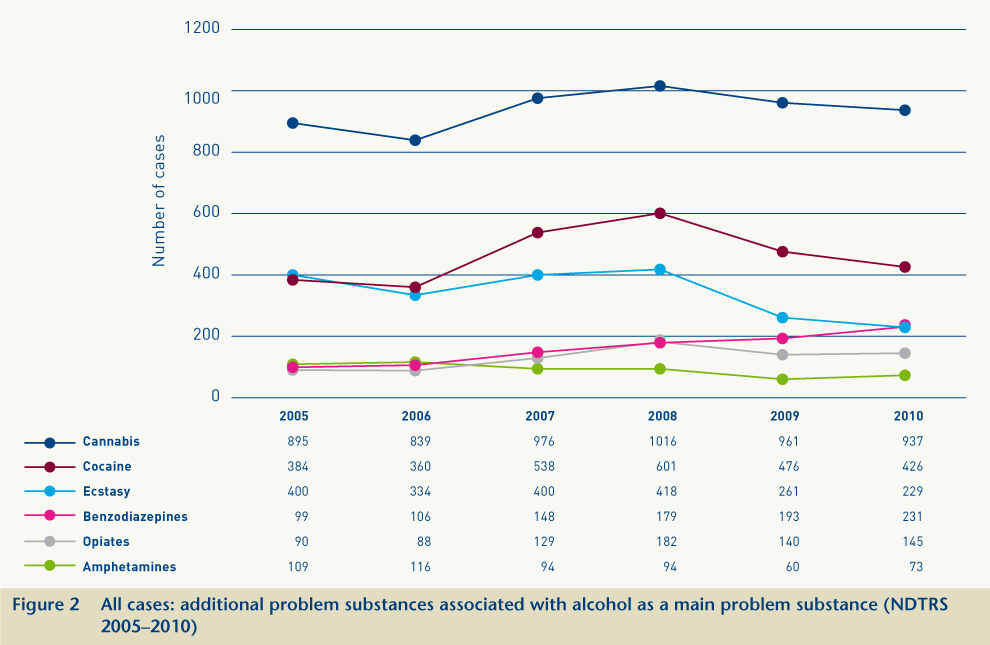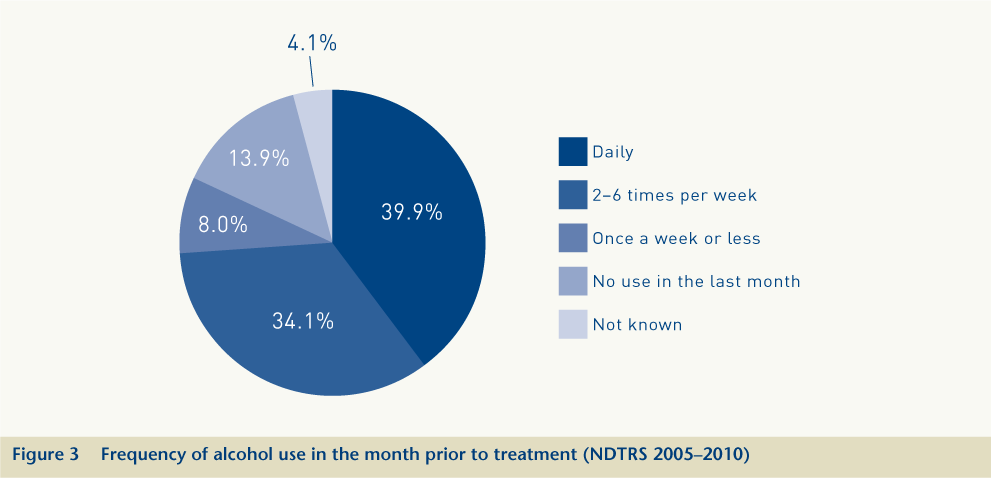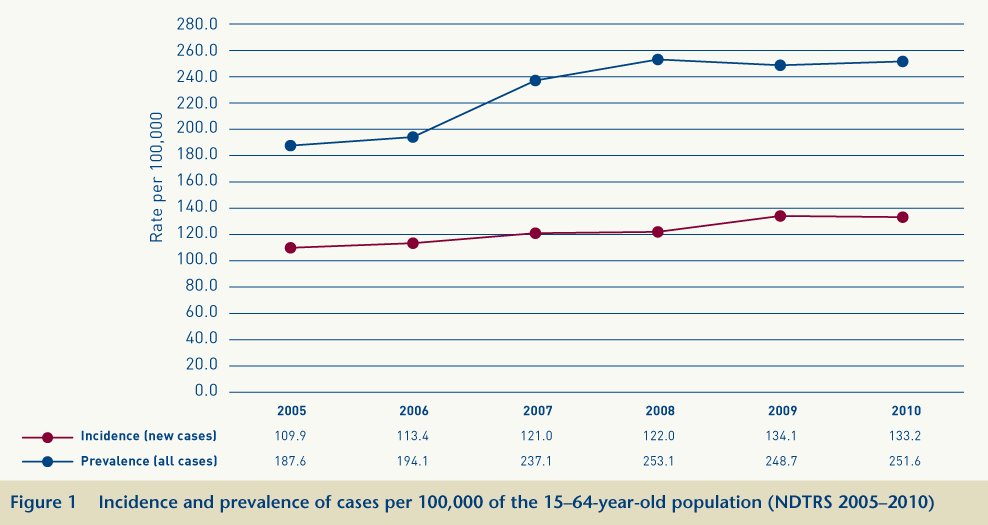A recent addition to the HRB Trends Series, Treated problem alcohol use in Ireland 2005 to 2010, was published in November 2011. Number 11 in the series, the paper is based on data reported to the National Drug Treatment Reporting System (NDTRS). It is important to note that the reporting system collects data on episodes of treatment, rather than the number of individual people treated each year. This means that individuals may appear more than once if they attend more than one treatment service in a year, and may reappear in subsequent years. The main findings of the paper are summarised below.
The incidence of cases treated for alcohol as a main problem drug was analysed by county for two distinct time periods: 2005–2007 and 2008–2010. In the period 2005–2007 the incidence rates per 100,000 of the 15–64-year-old population were highest in Sligo, Donegal, Leitrim, Waterford, Cavan and Wexford (with more than 200 cases per 100,000), and lowest in Mayo, Roscommon and Galway . The rates were also low in Dublin and Wicklow (with less than 100 cases per 100,000). These low rates may be explained by low levels of participation in the NDTRS by services in these counties prior to 2007. In the period 2008–2010 the incidence rates were highest in Waterford, Leitrim and Donegal and lowest in Wicklow, Clare and Laois.
The annual number of cases increased from 5,525 in 2005 to 7,866 in 2010. This increase reflects the growing number of treatment centres participating in the NDTRS, but may also point to an increase in the number of people presenting for treatment.
The number of new cases rose by 29.4%, from 3,228 in 2005 to 4,178 in 2010. The number of previously treated cases also increased (by 60.7%), from 2,229 in 2005 to 3,583 in 2009.
The largest proportion (39.4%) of cases in 2010 lived in the HSE South Region, and more than one quarter (25.6%) lived in the HSE West Region.

Substances used in conjunction with alcohol
Almost one in five of those treated for alcohol as a main problem substance also reported using at least one other substance. In 2010, the most common drugs used in conjunction with alcohol were cannabis, cocaine, benzodiazepines and ecstasy. This reflects a minor change since 2008, when opiates were the fourth most common additional drug. Use of more than one substance increases the complexity of cases and leads to poorer outcomes for the patient. Information about combinations of substances used is important in terms of individual clients’ care plans.

Patterns of alcohol use
The largest percentage (39.9%) of cases in the period 2005–2010 reported using alcohol daily (Figure 3).

In 2010, 31.0% used alcohol daily, 38.1% used it between two and six days per week, 9.0% used it once per week or less, and 17.5% had not used it in the month prior to entering treatment. In the same year, the figure for ‘daily use’ was higher for previously treated cases (33.2%) than for new cases (29.4%).
Half of all cases had begun drinking by the age of 16 years. This was true for new and previously treated cases. Of those who reported ever using drugs (10,336, 25.4%), the median age at which they commenced the illicit use of drugs remained constant over the reporting period. By the time they were 16 years old, half of all those treated for problem alcohol use had commenced the illicit use of drugs (excluding alcohol and tobacco).
The median age at which new cases commenced treatment was 36 years. Half of the new alcohol cases had used alcohol for 19 years or more before seeking treatment.
Socio-demographic characteristics
Half of those treated for alcohol as a main problem substance were aged 40 years or under. The age profile of cases remained similar throughout the reporting period. The median age for all treated cases was 39 years; the median age for new cases continued to be lower (36 years). While the proportion of cases aged under 18 years remained small, the number of new cases in that age group rose by 151.9% in the reporting period.
The socio-demographic characteristics of cases, both new and previously-treated, remained similar throughout the reporting period. The majority of cases were male, with low levels of employment. The proportion of cases in employment fell in the years 2008 to 2010, possibly reflecting the current economic climate. The proportion of cases who were homeless fell slightly between 2008 and 2009, but rose again in 2010: new cases from 2.4% to 1.5% to 2.3%, and previously-treated cases from 6.9% to 5.0% to 6.5%. Those who used other substances as well as alcohol were more likely to be unemployed and to live in unstable accommodation.
The findings and their implications are presented in detail in the Trends Series paper. An online Appendix to the paper, containing additional tables and figures with supplementary data, is available at https://www.drugsandalcohol.ie/16037
1. Carew AM, Bellerose D and Lyons S (2011) Trends in treated problem alcohol use in Ireland 2005 to 2010. HRB Trends Series 11. Dublin: Health Research Board.https://www.drugsandalcohol.ie/16037
Numbers treated
In the period 2005–2010, a total of 42,333 cases presented with alcohol as a main problem substance, accounting for more than half (52.7%) of all cases treated for problem substance use during that period.
The incidence of such cases increased from 109.9 per 100,000 of the 15–64-year-old population in 2005 to 133.2 per 100,000 in 2010. The prevalence increased from 187.6 per 100,000 in 2005 to 251.6 per 100,000 in 2010. This is an indication that problem alcohol use is a recurring addiction that requires repeated treatment over time. These increases in incidence and prevalence may be explained by a true increase in problem alcohol use in the population, an increase in reporting to the NDTRS, or a combination of both
 ORCID: https://orcid.org/0000-0002-8026-7228
(2012)
Trends in treated problem alcohol use.
Drugnet Ireland,
Issue 40, Winter 2011,
pp. 2-5.
ORCID: https://orcid.org/0000-0002-8026-7228
(2012)
Trends in treated problem alcohol use.
Drugnet Ireland,
Issue 40, Winter 2011,
pp. 2-5.



